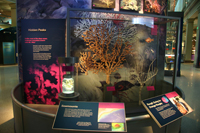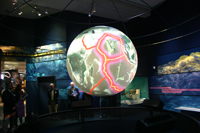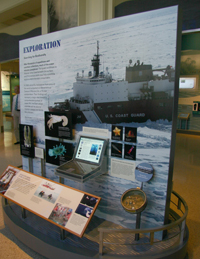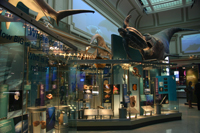The Ocean Comes to the Mall
NOAA Collaborates with Smithsonian Institution
September 25, 2008

Coral display.
High resolution (credit: NOAA )
Visitors to Washington, D.C. will find an exciting new way to explore the mysteries and wonders of the ocean right on the National Mall.
The Sant Ocean Hall — opening September 27 at the Smithsonian Institution’s National Museum of Natural History — combines 674 marine specimens and models, high-definition video experiences, one-of-a kind exhibits, and the newest technology, enabling visitors to explore the ocean’s past, present, and future as never before. The hall is the museum’s largest renovation since opening in 1910.
“For thousands of years people looked across the ocean and asked, ‘What lies beyond?’ Today we ask, ‘What lies below?’ and ocean explorers with new technologies are finding answers to those deep mysteries,” said retired Navy Vice Adm. Conrad Lautenbacher Jr., undersecretary of commerce for oceans and atmosphere and NOAA administrator. “Ocean Hall is unsurpassed in connecting people, in exciting ways, with the information needed to protect and manage our ocean and its resources. Ocean Hall is a fitting addition to the enriching museums currently on the National Mall.”

Science on a Sphere.
High resolution (credit: NOAA )
The Sant Ocean Hall was created in partnership with the National Oceanic and Atmospheric Administration (NOAA) to show the ocean as a global system that is essential to all life on Earth. The exhibition refers to ocean in the singular because the ocean is one huge, interconnected body of water that spans several basins.
Several hundred NOAA scientists and outreach specialists contributed to the Hall’s exhibit development which began in 2003. NOAA contributions can be found throughout the Hall, with NOAA technology on display in two major components: Science On A Sphere™ and the Ocean Today Kiosk.
NOAA’s Science On A Sphere™ will take visitors as if they were 22,000 miles in space where they will see ocean and atmospheric processes displayed across a spinning globe and understand why Earth is so appropriately called “the blue planet.” The Science On A Sphere™ was invented by Sandy MacDonald, director of NOAA’s Earth System Research Laboratory in Boulder, Colo.

Exploration display.
High resolution (credit: NOAA )
The NOAA Ocean Today Kiosk will take visitors outside the bounds of the museum through ever-changing news and feature videos. Through this experience, visitors can travel on board a fishing vessel, dive down to the deepest reaches of the sea, learn about the latest ocean science developments, see video of rare sea critters and underwater volcanoes or learn about marine debris or historical shipwreck discoveries.
NOAA will provide and update ocean stories on a regular basis. The videos will be provided not only to the touch-screen kiosks in the Sant Ocean Hall but also to kiosks in a growing network of aquariums across the nation through Coastal America’s Ecosystem Learning Centers. Some 20 to 30 million people in the United States, Mexico and Japan will have the opportunity to learn about the importance of ocean stewardship through this innovative NOAA product.
Phoenix, a 45-foot model of a living North Atlantic Right Whale, serves as the Hall’s signature symbol. There are 10 sections in the hall that address a variety of ocean-related topics, including the deep ocean, coral reefs, the Arctic and Southern Oceans and current ocean research. The Coral Reef section has a 1,500-gallon aquarium featuring an Indo-Pacific reef with over 1,000 specimens of more than 50 different species of live fish and other marine life. The hall’s “Journey through Time” section looks into the past with fossils of a large number of ancient organisms; some are more than 500 million years old. In the exhibit’s theater, a 13-minute video, “Deep Ocean Explorers,” takes visitors on a dive through the zones of the open ocean to the deep ocean bottom aboard the submersible, Alvin.

Main hall.
High resolution (credit: NOAA )
Other exhibits likely to be popular include two of the largest giant squids on display in the United States, “Ocean Odyssey,” a high-definition film by renowned underwater cinematographer Feodor Pitcairn, and only exhibit anywhere in the world of both an adult coelacanth (SEE-la-kanth) and its pup. This prehistoric fish was thought to have gone extinct 65 million years ago, until a fisherman caught one off the coast of South Africa in 1938.
“The ocean is a vast ecosystem essential to all life, including our own, yet scientific and public understanding of the ocean is still limited and most people are not aware of the profound effects of humans on marine life,” said Smithsonian Museum Director Cristián Samper. “That’s why the new Sant Ocean Hall is so vital and timely. It will greatly expand our knowledge of this extraordinary ocean planet we call home. Through its unparalleled collections, multimedia experiences and ongoing educational outreach and public programming, we hope this permanent exhibition will raise awareness of the importance of the ocean and the effect of human activities on marine life.”
